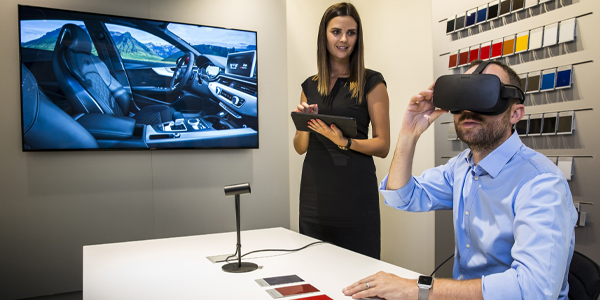
Technological Innovations Transforming Present-Day Retail

When e-commerce and online shopping were introduced for the first time in the 1990s, there were extensive predictions that online stores will replace majority of physical stores. However, major amount of sales still occurs via brick and mortar stores. In fact, a significant number of brands that started off as e-commerce platforms are now investing in physical retail outlets. These outlets overcome certain online barriers by allowing customers to examine the quality, strength and finish of products. This leads to ease in selection of items and reinforcement of faith in the brand. In order to meet consumer expectations, brick and mortar stores are evolving to maintain an intimate shopping experience as well as provide the convenience that is entailed by online shopping.
Brands are deploying technological and design innovations to overcome challenges of physical retail and enhance the customer experience. Attracting, engaging and retaining shoppers are major objectives across all industries. To assist with the same, digital technologies help to understand and incorporate evolving consumer needs, offer a diverse collection, personalize their experience, refine human resource investment, increase allegiances and enhance customer service. Technology empowers brands to break through the boundaries set by physical space, function and organization and explore new possibilities for the futuristic store.
This article aims to highlight how digital interventions are transforming shopping experience by making it simpler, faster and entertaining for customers, as well as helping retailers become omnichannel, improve sales, and manage logistics.
EASE THE CUSTOMER EXPERIENCE
Customer-product interaction is the most imperative aspect of retail store design. A customer is likely to purchase more products if the product interaction is hassle-free. But there are certain steps which cannot be eliminated. Considering the example of clothing stores, fitting rooms are an unavoidable part of the shopping experience. A 2016 survey by Body Labs found 46% of consumers “hate” trying on clothes in a fitting room. On the other hand, according to Alert tech, customers who try on clothes in store are almost seven times more likely to make a purchase than those who just browse items on the sales floor (Wasserman, CMO by Adobe). The conflicting statistics lead to a challenge which has been tackled using IT solutions by a some of the brands. Neiman-Marcus introduced a ‘Memory Mirror’ that functions both as a camera and screen to record an eight-second video so as to provide a 360-degree view of how a piece of clothing looks on. The shopper can also try two dresses and compare them side-by-side. This is topped by the email feature that allows the customer to share the clip with friends or family for a second opinion. Neiman-Marcus has thus set an impressive example of enhancing product interaction in the fashion industry.

Another challenge that terrifies shoppers, especially parents accompanied by their kids, is pushing around shopping carts in super markets. ‘JD.com’ opened its high-tech supermarket in 2017 named ‘7fresh’ and addressed this issue using an innovative tech solution. This market has robotic shopping carts which follow the shoppers as they browse through products and move around the supermarket. This technology allows the customers to keep their hands free, focus on children and other tasks.
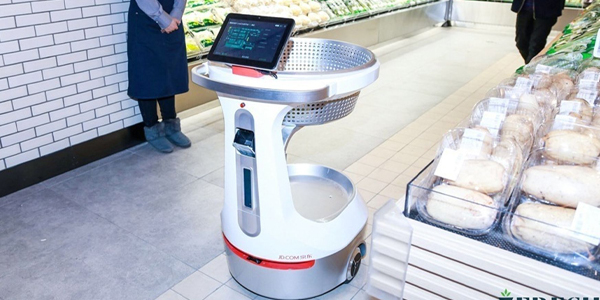
The idea of physical shopping is often accompanied by the horror of thronging crowds and long queues at the check-out counters. This is a significant aspect in the customer’s journey through a store. It determines the customers’ impression of the brand and whether or not they will come back. Therefore, in order to ease this step, a variety of IT solutions have been tried and tested. It started with the introduction of self-checkout kiosks. ‘Zara’ incorporated this system in 2018 to allow customers to skip long queues and avoid unnecessary human interaction. But this system still has some limitations such as requirement of extra floor space and the number of kiosks that can be installed are limited. Therefore, it is not certain that there won’t be any queues during a sale or before a major holiday. To overcome this challenge, ‘Amazon’ went a step ahead in its ‘Go’ stores by using sensor fusion technology to automate the checkout process. This system allows the customers to go to a store, pick-up items and leave without physically checking out. The payment is automatically made through the Amazon Go app (Gilliland, 2019). Innovations like this have significant design implications as well because of reduction in requirement of multiple checkout counters. This means that smaller floor areas can be utilised more efficiently by retailers to display and store their products.
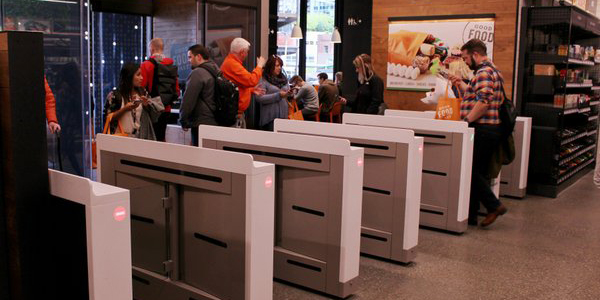
BLENDING THE ONLINE AND THE OFFLINE RETAIL
As mentioned in the beginning, we understand that a number of e-commerce-based brands are now coming up with physical stores as well. However, instead to utilizing the conventional retail formats, these brands have smartly incorporated features that give them an edge over their competitors. Since customer convenience is the most outstanding factor of online shopping, some of the brands are successfully incorporating it into their retail outlets. The Chinese e-commerce company, Alibaba opened its supermarket named ‘Hema’ in 2016. The store allows customers to scan the QR codes on the products to read up relevant information like the exact dates when the food items were harvested, sourced, and delivered. In addition to this, the store allows self-checkout via the Hema app to make the shopping experience more convenient. Supermarkets have a tremendous scope for innovation as they interact with a set of customers on a daily basis. Technological interventions are essential to enhance and ease the customer journey as well as allow the retailer to be more sustainable. Digital shelves, app-based information display, carts and checkouts are some of the features shaping the future of hypermarkets.
As far as the fashion industry is concerned, brands have gone a step above to combine the online and offline elements. In 2018, Nike introduced a flagship store in New York named ‘Nike House of Innovation 00’. This futuristic store houses customisation studios, instant checkout points, and a ‘Speed shop’. The Nike Speed Shop allows the customers to reserve shoes online to try on in-store. Customers can conveniently enter from a different entrance to find a locker with their name on, which can then be unlocked via their smartphone (Gilliland, 2019). Beyond this point, the customers may purchase the product instantly or place an order online from their smartphones. It is usually observed that people avoid shopping wearables online as it is difficult for them to make a decision without trying on an item. Interestingly, features like the Nike Speed Shop bridges this gap and attract more shoppers than the online platforms by offering the option of trying on the product before making a purchase.
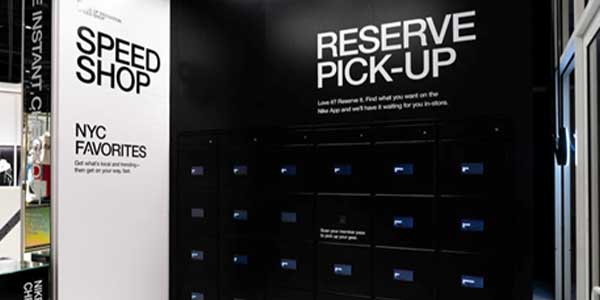
ENTERTAINING THE SHOPPERS
The thing about customers these days is that they need to be serenaded more than they need to be sold to. Entertainment in retail help the brands stand out and be recognized distinctively in the market. Moreover, it helps the brands develop better customer relationships. According to Synchrony Financial, a survey report reveals that over 55% of participants registered interest in in-store experiences that entertain them. This has resulted in a widespread use of technological solutions like virtual and augmented reality. Audi’s global showrooms introduced a VR experience of its customers in 2017. This system allows the customers to configure their own car while explored the car’s interior and exterior in realistic detail (Gilliland, 2019). The technology also constitutes additional features for the consumer to experience the atmosphere of a race-course pit-stop.

Some brands have been noted to go a step ahead by introducing additional facilities other than their primary ones. Hema, by Alibaba, houses an in-store dining area which is empowered by robots. The consumers may also use the Hema app to book a table and order items. Once the meals are prepared, robots move around the items from the kitchen to serve them to the customer. An extremely interesting experience for the customers has a great impact on the retailer as well. Reduced floor area requirement and elimination of waiting staff opens up miscellaneous possibilities.
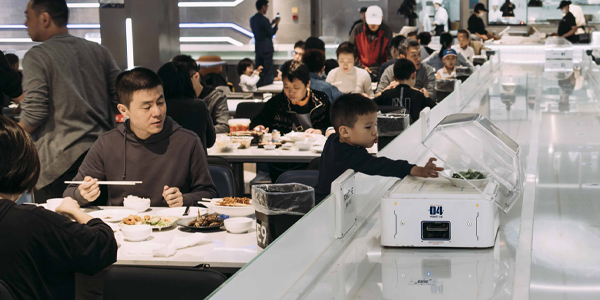
INSTORE AND OFFSTORE MANAGEMENT
While these experiences keep customers engaged, digital technology does wonders for the retailer as well. Tracking the in store and warehouse stock using smart robotics and computer systems improves inventory management and reduces the chances of waste, spoilage, and even theft. Studio MESO helped launching an online brand Lullabuy (Kids Clothing) in a Retail space in India. In order to connect the inventory online and offline, we introduced a tablet in the store for inventory rotation. Automated systems help improve inventory control. It allows the retailer to keep track of reliable stock data in real time. It further helps the manager to manage stock flow, make solid predictions, smart decisions, and forecasting. For example, if the physical inventory runs out of a product of certain size or colour, customer/store manager is encouraged to order it online to avoid loss on spot purchases.
Another IT intervention that’s changing shopping is robotic store assistants. Robots have the advantage to interact with customers in various languages. They can help customers in finding what they need and conveying any special offers available in the store. This technology presents diverse opportunities. It can be combined with face recognition to provide a more personalised experience to the customers by responding to their unique needs. Lowe, the home improvement brand introduced ‘Lowebot’ in 2016 at its stores in San Francisco. While the autonomous retail service robot answers simple questions and assists with inventory monitoring, the store employees can spend more time offering their expertise and specialised knowledge to customers (Lowe’s innovation labs).
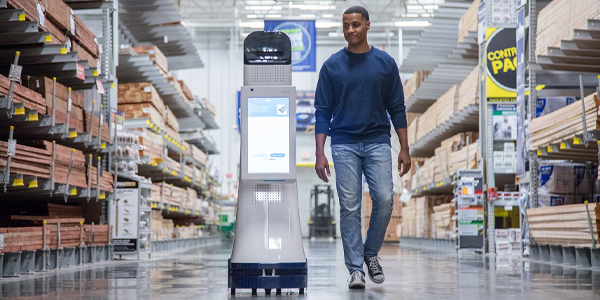
Needless to say, physical retail is not going anywhere. Such technological and design concepts are transforming the possibilities in the future of retail outlets. With current COVID-19 scenario across the world, creative technology intervention seems like the only way to avoid any customer fall out and retain sales with utmost detail and hygiene levels. We continue to see adaptions and integration at various levels to enable a smooth retail experience as the world presses reboot button. In the present day and age, innovations like this are not only essential for an enhanced customer experience but contribute significantly to the growing need of sustainability. Retailers continue to incorporate and be rewarded due to the use of innovative technology.

1 comments